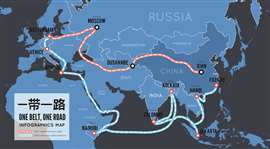The 6 project types China is expected to target under BRI
06 February 2024

China is expected to focus on six types of projects as it grows engagement under its Belt & Road Initiative (BRI) this year.
That’s according to new report into BRI, which reached its 10th anniversary last year, compiled by the Green Finance & Development Centre together with the Griffith Asia Institute.
The report found that the total value of China’s BRI engagement has passed the US$1 trillion mark over the course of the last decade, including a cumulative total of US$634 billion worth of construction contracts.
Dubbed the world’s most ambitious infrastructure initiative, it had appeared that China was pivoting away from investment in new projects beyond its borders, as it found itself increasingly having to act as a lender of last resort for developing nations struggling to repay their BRI debts.
But the new report predicted that there would be further growth of BRI engagement in 2024, with a “strong focus” on country partnerships in renewable energy, mining and related technology.
It forecast future engagements by China with the 150 countries that have signed a cooperation agreement under six project types in particular:
- Manufacturing in new technologies (such as batteries for electric vehicles)
- Trade-enabling infrastructure (including pipelines and roads)
- Information and communication technologies projects (highlighting data centres as a particular growth area)
- High-visibility or strategic projects (such as new railways)
- Renewable energy
- Resource-backed deals (for example, mining, oil and gas)
Nonetheless, there are signs that China’s BRI strategy is changing, as more than 50% of BRI engagement came through investment as opposed to construction deals for the first time in 2023.
Investments reached about 59% of BRI engagement last year, compared to 29% in 2021.
China has previously been reported to have started to favour “small and beautiful” projects as opposed to expensive infrastructure megaprojects.
The report showed that while the average deal size for investments has more than doubled from a low of US$354 million in 2020 to $772 million in 2023, for construction projects the deal size was the second lowest since the launch of the BRI in 2013, at about US$394 million.
That represented a decline of 22% and the report stated that the trend was “in line” with the ambition to run “small and beautiful” projects under the BRI as China adjusted its risk management strategies to avoid problems with sovereign debt.
Africa becomes largest recipient of BRI engagement
Meanwhile, Africa became the largest recipient of BRI engagement, with a 47% increase in Chinese construction contracts and 114% increase in investments on the continent in 2023.
Chinese engagement in Africa was worth US$21.7 billion over the course of the year, according to the report, overtaking Middle Eastern countries, which saw US$15.8 billion of engagement.
The report also found that east Asia was a growth area for the BRI. Countries in the region expanded their intake of Chinese investments by 94% to US$6.8 billion in 2023.
By contrast, Latin American BRI countries saw low construction engagement (construction contracts signed with Chinese contractors, typically involving Chinese debt financing) in 2023, with a total of US$180 million. However, investment in Latin American BRI countries increased by 92% to about US$5.5 billion.
Saudi Arabia was boom area for Chinese construction companies
The country with the highest construction volume for Chinese construction firms was Saudi Arabia, the report found. Chinese construction engagement totalled about US$5.6 billion in 2023, up from $2.6 billion for the previous year.
 The Maputo-Katembe bridge in Mozambique, the longest suspension bridge on the African continent, was built under China’s Belt and Road initiative (Image: Malajscy via AdobeStock - stock.adobe.com)
The Maputo-Katembe bridge in Mozambique, the longest suspension bridge on the African continent, was built under China’s Belt and Road initiative (Image: Malajscy via AdobeStock - stock.adobe.com)
That was followed by Sri Lanka ($4.5 billion), Tanzania ($3.1 billion) and the United Arab Emirates ($2.1 billion).
A total of 45 countries around the world saw construction engagement from China during the year, while 37 countries received investments.
But a total of 19 countries saw a 100% drop in BRI engagement as compared to 2022. That included Kenya, Myanmar and China. Meanwhile, China’s engagement in Pakistan for the China Pakistan Economic Corridor (CPEC) fell by 74%.
Russia, which did not receive any Chinese engagement in 2022, saw Chinese engagement in one project in 2023, with China National Chemical Engineering Corporation (CNCEC) joining AEON Corporation to build a methanol plant in Volgograd.
To read the full report, click here.
FROM OUR PARTNERS
|
STAY CONNECTED



Receive the information you need when you need it through our world-leading magazines, newsletters and daily briefings.
CONNECT WITH THE TEAM








